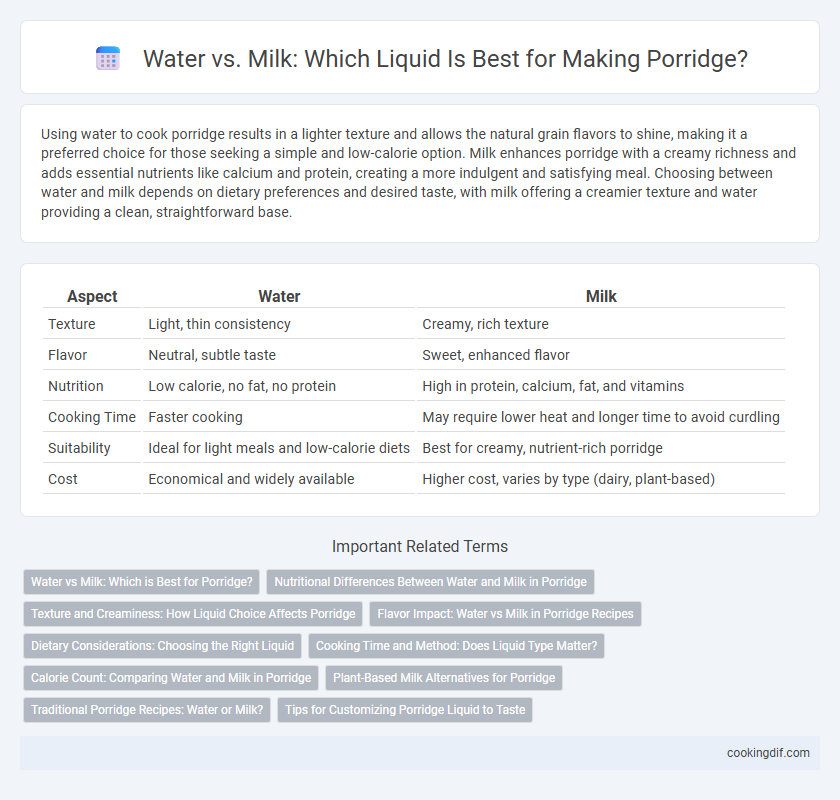Using water to cook porridge results in a lighter texture and allows the natural grain flavors to shine, making it a preferred choice for those seeking a simple and low-calorie option. Milk enhances porridge with a creamy richness and adds essential nutrients like calcium and protein, creating a more indulgent and satisfying meal. Choosing between water and milk depends on dietary preferences and desired taste, with milk offering a creamier texture and water providing a clean, straightforward base.
Table of Comparison
| Aspect | Water | Milk |
|---|---|---|
| Texture | Light, thin consistency | Creamy, rich texture |
| Flavor | Neutral, subtle taste | Sweet, enhanced flavor |
| Nutrition | Low calorie, no fat, no protein | High in protein, calcium, fat, and vitamins |
| Cooking Time | Faster cooking | May require lower heat and longer time to avoid curdling |
| Suitability | Ideal for light meals and low-calorie diets | Best for creamy, nutrient-rich porridge |
| Cost | Economical and widely available | Higher cost, varies by type (dairy, plant-based) |
Water vs Milk: Which is Best for Porridge?
Choosing between water and milk as the liquid for porridge greatly impacts its texture and nutritional value. Water produces a lighter, more traditional porridge with fewer calories, while milk creates a creamier, richer consistency packed with protein and calcium. For those seeking a balance of flavor and health benefits, using a blend of water and milk offers both hydration and enhanced creaminess.
Nutritional Differences Between Water and Milk in Porridge
Using milk instead of water in porridge significantly increases its protein, calcium, and vitamin D content, enhancing bone health and muscle function. Water-based porridge contains fewer calories and lacks the fat and sugar naturally present in milk, making it a lighter option suitable for calorie-conscious diets. The choice between water and milk impacts the texture and nutritional density of porridge, influencing dietary needs and health goals.
Texture and Creaminess: How Liquid Choice Affects Porridge
Using milk instead of water to prepare porridge significantly enhances its creaminess and produces a richer, smoother texture due to the fat and protein content in milk. Water-based porridge tends to be lighter and less creamy, resulting in a more porridge with a thinner consistency that highlights the oats' natural flavor. The choice of liquid directly impacts the mouthfeel, with milk creating a velvety finish and water offering a more traditional, grainy texture.
Flavor Impact: Water vs Milk in Porridge Recipes
Using milk as the liquid base in porridge recipes enhances the flavor by adding richness, creaminess, and a subtle sweetness that water cannot provide. Water-based porridge has a lighter, more neutral taste, allowing toppings and spices to stand out without interference from the liquid. The choice between water and milk ultimately shapes the overall sensory experience, with milk offering a more indulgent and satisfying flavor profile.
Dietary Considerations: Choosing the Right Liquid
Using water for porridge reduces calorie and fat content, making it ideal for low-calorie and low-fat diets. Milk, especially whole or enriched varieties, adds protein, calcium, and essential vitamins, supporting bone health and muscle maintenance. For lactose-intolerant or vegan individuals, plant-based milks like almond or oat offer nutritious alternatives without dairy-related digestive issues.
Cooking Time and Method: Does Liquid Type Matter?
Choosing water or milk as the cooking liquid for porridge affects both texture and cooking time; water typically cooks faster due to lower viscosity, allowing oats to absorb moisture more quickly. Milk, rich in proteins and fats, requires a gentler simmer and longer cooking to prevent curdling and achieve a creamy consistency. The method adapts accordingly--water-based porridge benefits from a vigorous boil, while milk-based versions demand careful, low heat to maintain a smooth, thickened result.
Calorie Count: Comparing Water and Milk in Porridge
Water contains zero calories, making it the lowest-calorie option for preparing porridge and ideal for those monitoring calorie intake. Milk adds significant calories due to its natural sugars and fats, with whole milk contributing approximately 150 calories per cup, which enhances the creaminess and nutritional profile. Choosing water results in a lighter porridge, while milk provides extra protein, calcium, and a richer texture, affecting overall calorie count and dietary goals.
Plant-Based Milk Alternatives for Porridge
Plant-based milk alternatives such as almond milk, oat milk, and soy milk offer a creamy texture and subtle flavor that enhance porridge without the lactose found in dairy milk. Oat milk, in particular, complements porridge by adding natural sweetness and fiber, boosting its nutritional profile. Using water results in a lighter porridge but lacks the richness and nutrients provided by plant-based milks, which also cater to vegan and lactose-intolerant diets.
Traditional Porridge Recipes: Water or Milk?
Traditional porridge recipes often vary between using water or milk as the cooking liquid, each imparting unique textures and flavors. Water-based porridge delivers a lighter, more neutral taste, emphasizing the natural flavor of oats, while milk-based porridge creates a creamier, richer consistency enriched with additional nutrients like calcium and protein. The choice between water and milk depends on dietary preferences and nutritional goals, with some classic recipes blending both for balanced texture and flavor.
Tips for Customizing Porridge Liquid to Taste
Using water results in a lighter, more neutral-flavored porridge, allowing the natural taste of oats to shine, while milk adds creaminess and a richer texture with a subtle sweetness. For a balanced flavor, try mixing half water and half milk to achieve a creamy consistency without overpowering the oats. Adjust the liquid ratio based on desired thickness and flavor intensity, and consider plant-based milks like almond or oat milk for additional taste variety and dietary preferences.
Water vs Milk for porridge liquid Infographic

 cookingdif.com
cookingdif.com